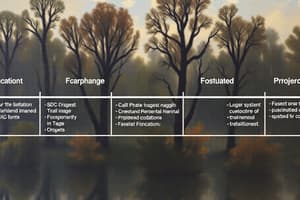Podcast
Questions and Answers
What do business rules represent in a system?
What do business rules represent in a system?
- Constraints that must be followed during system operation (correct)
- Technical implementation details of the system
- Hierarchical decomposition of system processes
- Logical data flows between system components
What do ERD symbols show about the relationship between entity instances?
What do ERD symbols show about the relationship between entity instances?
- The physical implementation details of the system
- The logical data flows between system components
- The cardinality and optionality of relationships between entities (correct)
- The hierarchical decomposition of system processes
What is the purpose of the Physical Process Model?
What is the purpose of the Physical Process Model?
- To show the hierarchical decomposition of system processes
- To show the implementation details and explain how the system will work (correct)
- To show the logical data flows between system components
- To show the business rules and constraints that must be followed during system operation
What is the relationship between the Logical DFD and the Physical DFD?
What is the relationship between the Logical DFD and the Physical DFD?
Which of the following is a key purpose of process decomposition?
Which of the following is a key purpose of process decomposition?
What is the purpose of an Entity Relationship Diagram (ERD)?
What is the purpose of an Entity Relationship Diagram (ERD)?
Flashcards are hidden until you start studying
Study Notes
Systems Development Life Cycle (SDLC)
- SDLC consists of five phases: Planning, Analysis, Design, Implementation, and System Request
- Planning Phase:
- Project Initiation: prepare system request, perform preliminary feasibility analysis, and set up the project
- Project Plan, including work plan and staffing plan
- Analysis Phase:
- Determine analysis strategy, study existing system and its problems
- Collect and analyze requirements, develop new system concept, and describe new system with analysis models
- Prepare and present system proposal, summarize results of the Analysis Phase, and make a Go/No Go decision
- Design Phase:
- Determine design strategy, build/buy/outsource, design system components, architecture, interface, database, and programs
- Assemble design elements into system specification, present to steering committee, and make a Go/No Go decision
- Implementation Phase:
- System construction, programming, and testing
- System installation, training, conversion to new system, and on-going system support
- System Request:
- Describes business reasons for the project
- Defines system's expected value
- Provides a framework for collecting initial project information
- Standardizes information to be used by steering (approval) committee
- Lists project's key elements
Feasibility Analysis
- Detailed business case for the project
- Technical feasibility
- Economic feasibility
- Organizational feasibility
- Compiled into a feasibility study
- Critically important to reassess feasibility throughout the project
Fact-Finding Techniques
- Interviews
- Joint Application Design
- Questionnaires
- Document Analysis
- Observation
- Type of information: As-is, improvements, to-be
- Depth and breadth of information
- User involvement
- Cost
Object-Oriented Systems Analysis & Design
- Characteristics: Use-case driven, architecture centric, iterative, and incremental
- Classes and objects
- Attributes: information that describes the class
- State: describes its values and relationships at a point in time
- Methods and messages
- Encapsulation and information hiding
- Inheritance
- Object-oriented systems analysis and design
- Use-cases define the behavior of a system
- Each use-case focuses on one business process
- Architecture centric: functional, static, and dynamic views
- Iterative and incremental: continuous testing and refinement
Business Process Identification with Use-Cases
- Review the requirements definition
- Identify the subject's boundaries
- Identify primary actors and their goals
- Identify business processes and major use-cases
- Review the current set of use-cases
- Split or combine them to create the right size
- Identify additional use-cases
Data Flow Diagrams (DFDs)
- Elements:
- Process
- Data flow
- Data store
- External entity
- Process: an activity or function performed for a specific business reason
- Data flow: a single piece of data or a logical collection of data
- Data store: a collection of data that is stored in some way
- External entity: a person, organization, or system that is external to the system
- Depicting business processes with DFDs: create a hierarchy with multiple levels of DFDs
Physical Process Model
- Shows the implementation details and explains how the system will work
- Includes actual, specific technology
- Format of information
- Human interaction with the system
Studying That Suits You
Use AI to generate personalized quizzes and flashcards to suit your learning preferences.




